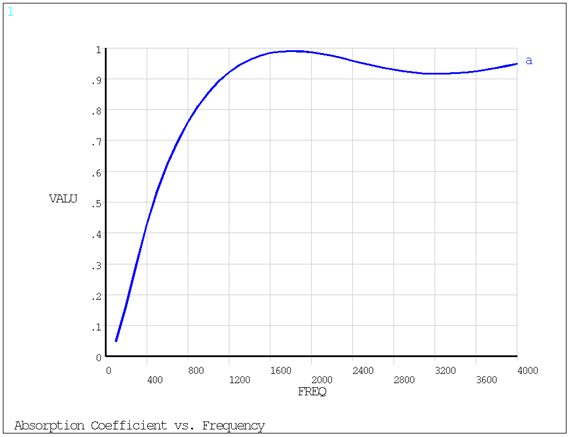VM242
VM242
Johnson-Champoux-Allard Equivalent Fluid Model
Overview
| Reference: | O. Doutres, Y. Salissou, N. Attalla, R. Panneton, “Evaluation of the acoustic and non-acoustic properties of sound absorbing materials using a three-microphone impedance tube”, Applied Acoustics 71. (2010). pp 506-509. |
| Analysis Type(s): | Harmonic Analysis (ANTYPE = 3) |
| Element Type(s): | 3D Acoustic Fluid 20-Node Solid Element (FLUID220) |
| Input Listing: | vm242.dat |
Test Case
The absorption coefficient of a sound absorbing porous material (Material A) is determined and compared against the target value shown in the reference. It is evaluated using the indirect method based on a three-microphone impedance tube setup. The sound absorption coefficient is predicted by the five-parameter Johnson-Champoux-Allard equivalent fluid model.
| Material Properties | Geometric Properties |
|---|---|
|
Speed of sound: 343 m/s Density: 1.2 kg/m3 Fluid resistivity: 10800 Ns/m4 Porosity: 0.98 Tortuosity: 1.04 Viscous characteristic length: 129 μm Thermal characteristic length: 198 μm |
Depth of sound-absorbing material: 51.44 mm |
Analysis Assumptions and Modeling Notes
Due to the 1D nature of the waves, an arbitrary width (smaller than the wavelength) is used to create a row of fluid elements for this model. The loading is not important in this application, so an arbitrary value is used: a planar mass source that would create 1e3 Pa pressure waves in an infinite pipe is applied. The sound source is specified with Robin boundary surface to absorb reflected waves out of the system.
The impedance is calculated at the interface of the sound-absorbing material, and from that, the absorption coefficient is calculated and compared with the reference.
The specific acoustic impedance Z is calculated as the ratio of the pressure P and velocity ν at the interface. The ratio ζ of specific acoustic impedance Z to the characteristic impedance (product of density ρ and speed of sound c) can be related to the reflection coefficient R. The absorption coefficient α can be determined from the reflection coefficient R. These calculations are done in the Time-History Postprocessor /POST26 over the calculated frequency range.



